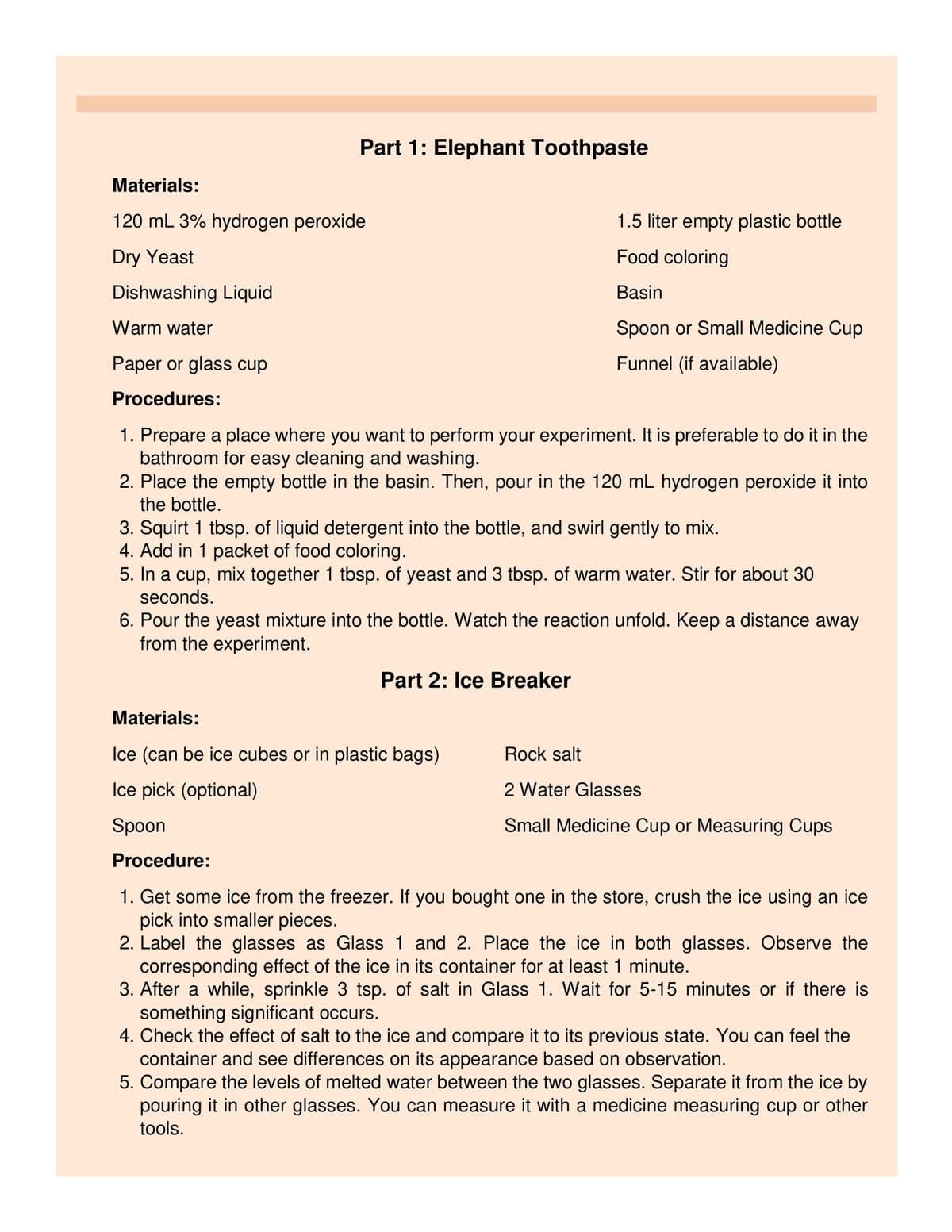Why is that the surrounding temperature of ice cubes is cold and has condensation? What process (reaction) takes place? Is it endothermic or exothermic ?
Why is that the surrounding temperature of ice cubes is cold and has condensation? What process (reaction) takes place? Is it endothermic or exothermic ?
Chemistry: The Molecular Science
5th Edition
ISBN:9781285199047
Author:John W. Moore, Conrad L. Stanitski
Publisher:John W. Moore, Conrad L. Stanitski
Chapter13: The Chemistry Of Solutes And Solutions
Section: Chapter Questions
Problem 57QRT
Related questions
Question
- Why is that the surrounding temperature of ice cubes is cold and has condensation? What process (reaction) takes place? Is it endothermic or exothermic ?
- In the photo given, describe which of the experiments are exothermic or endothermic. Explain on how each reaction should be defined.

Transcribed Image Text:Part 1: Elephant Toothpaste
Materials:
120 mL 3% hydrogen peroxide
1.5 liter empty plastic bottle
Dry Yeast
Food coloring
Dishwashing Liquid
Basin
Warm water
Spoon or Small Medicine Cup
Paper or glass cup
Funnel (if available)
Procedures:
1. Prepare a place where you want to perform your experiment. It is preferable to do it in the
bathroom for easy cleaning and washing.
2. Place the empty bottle in the basin. Then, pour in the 120 mL hydrogen peroxide it into
the bottle.
3. Squirt 1 tbsp. of liquid detergent into the bottle, and swirl gently to mix.
4. Add in 1 packet of food coloring.
5. In a cup, mix together 1 tbsp. of yeast and 3 tbsp. of warm water. Stir for about 30
seconds.
6. Pour the yeast mixture into the bottle. Watch the reaction unfold. Keep a distance away
from the experiment.
Part 2: Ice Breaker
Materials:
Ice (can be ice cubes or in plastic bags)
Rock salt
Ice pick (optional)
2 Water Glasses
Spoon
Small Medicine Cup or Measuring Cups
Procedure:
1. Get some ice from the freezer. If you bought one in the store, crush the ice using an ice
pick into smaller pieces.
2. Label the glasses as Glass 1 and 2. Place the ice in both glasses. Observe the
corresponding effect of the ice in its container for at least 1 minute.
3. After a while, sprinkle 3 tsp. of salt in Glass 1. Wait for 5-15 minutes or if there is
something significant occurs.
4. Check the effect of salt to the ice and compare it to its previous state. You can feel the
container and see differences on its appearance based on observation.
5. Compare the levels of melted water between the two glasses. Separate it from the ice by
pouring it in other glasses. You can measure it with a medicine measuring cup or other
tools.
Expert Solution
This question has been solved!
Explore an expertly crafted, step-by-step solution for a thorough understanding of key concepts.
Step by step
Solved in 2 steps

Knowledge Booster
Learn more about
Need a deep-dive on the concept behind this application? Look no further. Learn more about this topic, chemistry and related others by exploring similar questions and additional content below.Recommended textbooks for you

Chemistry: The Molecular Science
Chemistry
ISBN:
9781285199047
Author:
John W. Moore, Conrad L. Stanitski
Publisher:
Cengage Learning

EBK A SMALL SCALE APPROACH TO ORGANIC L
Chemistry
ISBN:
9781305446021
Author:
Lampman
Publisher:
CENGAGE LEARNING - CONSIGNMENT

Chemistry: Matter and Change
Chemistry
ISBN:
9780078746376
Author:
Dinah Zike, Laurel Dingrando, Nicholas Hainen, Cheryl Wistrom
Publisher:
Glencoe/McGraw-Hill School Pub Co

Chemistry: The Molecular Science
Chemistry
ISBN:
9781285199047
Author:
John W. Moore, Conrad L. Stanitski
Publisher:
Cengage Learning

EBK A SMALL SCALE APPROACH TO ORGANIC L
Chemistry
ISBN:
9781305446021
Author:
Lampman
Publisher:
CENGAGE LEARNING - CONSIGNMENT

Chemistry: Matter and Change
Chemistry
ISBN:
9780078746376
Author:
Dinah Zike, Laurel Dingrando, Nicholas Hainen, Cheryl Wistrom
Publisher:
Glencoe/McGraw-Hill School Pub Co

World of Chemistry
Chemistry
ISBN:
9780618562763
Author:
Steven S. Zumdahl
Publisher:
Houghton Mifflin College Div

Chemistry for Engineering Students
Chemistry
ISBN:
9781285199023
Author:
Lawrence S. Brown, Tom Holme
Publisher:
Cengage Learning
